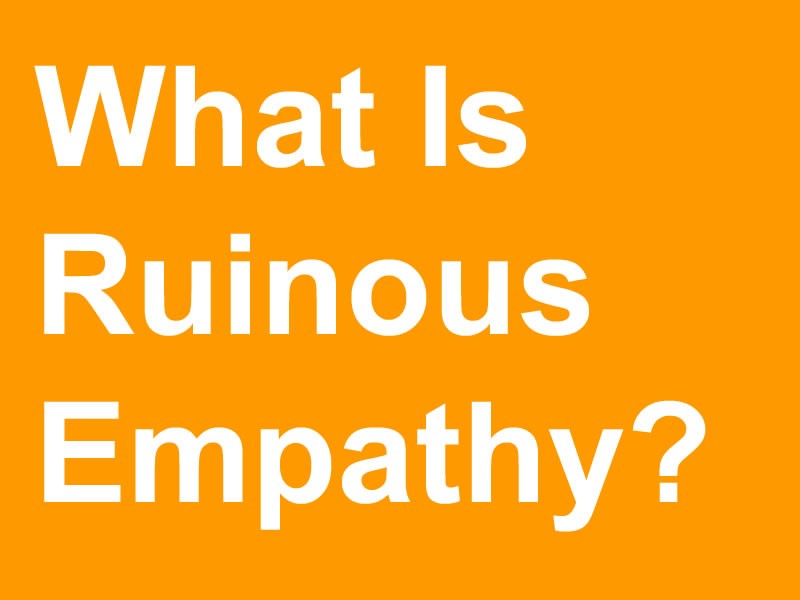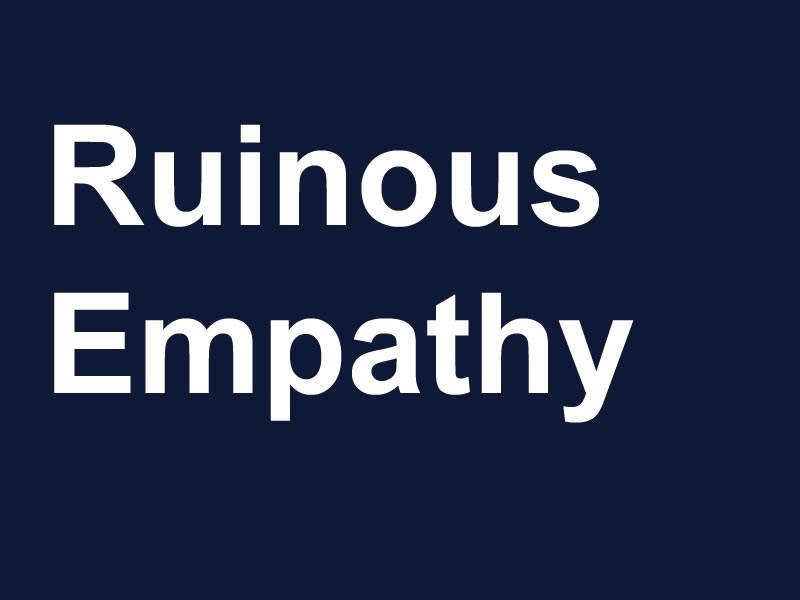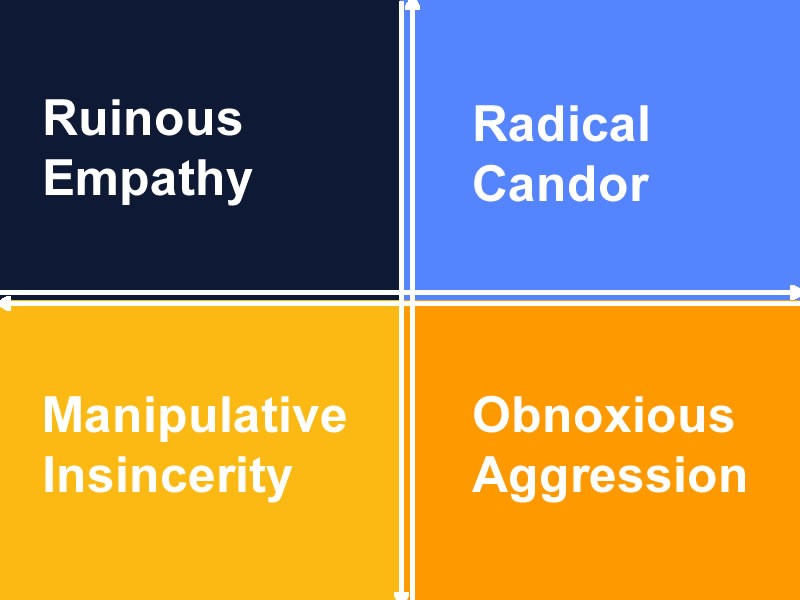Insight Blog
Agility’s perspectives on transforming the employee's experience throughout remote transformation using connected enterprise tools.
13 minutes reading time
(2545 words)
Ruinous Empathy Quadrant - What Is It, Examples & More
Explore the ruinous empathy quadrant, its impact on communication, and strategies for healthier interpersonal relationships.
The ruinous empathy quadrant, an integral part of the emotional intelligence framework, plays a pivotal role in shaping interpersonal dynamics in the workplace.
This concept, central to understanding and managing both personal emotions and those of others, profoundly influences interactions, teamwork, and conflict resolution within professional environments.
Ruinous empathy emerges when an individual, in a well-meaning attempt to avoid causing hurt or discomfort, refrains from offering honest feedback or necessary criticism. Characterized by a blend of care and passivity, this approach, though rooted in kindness, can lead to harmful outcomes, affecting both personal development and organizational productivity.
This article sets out to explore the ruinous empathy quadrant in depth. It aims to dissect its foundations and manifestations and contrast with more direct communication styles like radical candor.
Our objective is to not only define and describe this concept but also to provide practical insights for recognizing and counteracting its negative impacts. In doing so, we strive to cultivate a workplace atmosphere that is both honest and empathetic, promoting growth and efficiency.
What Is Ruinous Empathy?
So, what is ruinous empathy?
It is a term gaining traction in contemporary discussions on workplace dynamics and refers to a kind of interaction where excessive concern for another's feelings leads to a failure to offer honest feedback or constructive criticism.
It is marked by a well-intentioned yet misguided effort to protect others from potential discomfort or hurt, often at the expense of personal growth or organizational success. This approach, while stemming from a place of kindness and empathy, paradoxically results in negative outcomes by hindering clear communication and fostering a culture of unaddressed issues and unmet potential.
Central to ruinous empathy is the reluctance to confront difficult truths. This can manifest as sugarcoating feedback, avoiding tough conversations, or neglecting to provide critical guidance that could help others improve.
While it springs from a desire to maintain harmony and avoid conflict, ruinous empathy can ultimately lead to misunderstandings, decreased morale, and lower productivity. Its impact is not limited to professional growth; it also stymies personal development by depriving individuals of the opportunity to learn from mistakes and to embrace challenges.
Understanding and identifying ruinous empathy is crucial for fostering a culture of open, honest, and effective communication, thereby enabling individuals and teams to thrive.
Distinguishing Ruinous Empathy from Other Types of Interpersonal Interactions
Ruinous empathy, while sharing certain characteristics with other interpersonal interactions, stands distinct in its nature and consequences.
This differentiation is vital for comprehending its unique impact within the spectrum of workplace communication. One key distinction lies in its comparison with straightforward honesty, often termed as "radical candor." While radical candor also stems from a place of care, it balances this with directness, ensuring that feedback, though potentially tough, is delivered in a clear and helpful manner.
Ruinous empathy, on the other hand, errs on the side of caution to such an extent that vital feedback is either diluted or completely withheld, sacrificing clarity for comfort.
Contrastingly, aggressive communication, another common interaction style, lacks the underlying empathy that marks ruinous empathy. Aggressive communicators prioritize their message over the feelings of the receiver, often leading to a hostile environment. Ruinous empathy, in contrast, is overly concerned with the receiver's emotions to the point where it becomes detrimental.
Another interaction style is passive communication, where individuals avoid expressing their thoughts and needs altogether. This differs from ruinous empathy, where the communicator does engage but does so in a manner that fails to convey the necessary hard truths.
Also, passive-aggressive communication, characterized by indirect expression of negative feelings or hostility, contrasts sharply with ruinous empathy. While the latter comes from a place of genuine care and concern, passive-aggressive behavior often stems from an inability or unwillingness to confront issues directly.
Psychological Underpinnings of Ruinous EmpathyEnter heading here...
The psychological underpinnings of ruinous empathy are deeply rooted in human emotional and cognitive processes. At its core, this phenomenon is driven by a fundamental human instinct to avoid causing discomfort or pain to others. This instinct, while beneficial in nurturing compassion and empathy, can become counterproductive when it impedes honest and necessary communication.
A key factor in the emergence of ruinous empathy is the fear of conflict or negative reactions. Many individuals naturally shy away from potentially confrontational situations, particularly in a workplace setting where harmonious relationships are crucial.
This avoidance is often compounded by a lack of confidence in one's ability to deliver tough feedback in a constructive manner, leading to a preference for silence or sugarcoating over potential discord.
Another psychological aspect is the desire for acceptance and belonging. In a professional context, this can translate into an excessive need to be liked or to maintain a positive image, which in turn motivates the avoidance of any actions that might be perceived as critical or harsh.
Furthermore, cognitive biases such as the 'halo effect' can also play a role. This bias leads individuals to overlook or downplay negative aspects or behaviors of someone they otherwise view positively, further fueling ruinous empathy.
Follow us and access great exclusive content everyday: Follow us on Google News
Understanding the Ruinous Empathy Quadrant
Detailed Description of the Ruinous Empathy Quadrant
The ruinous empathy quadrant is a critical component of the emotional intelligence framework, specifically focusing on the impact of excessive empathy in interpersonal interactions.
This quadrant is characterized by high levels of care and personal concern for others but markedly low in challenging directly or providing candid feedback. It sits in contrast to other quadrants that balance empathy with directness or lack empathy altogether.
In this quadrant, the dominant behavior is driven by a desire to spare others' feelings, leading to a communication style that is overly nurturing, often at the expense of honesty and growth. Feedback, if given, is vague and non-confrontational, avoiding any form of critique that could be perceived as harsh.
While this may create a superficially pleasant environment, it ultimately hinders personal and professional development, as individuals are not provided with the necessary insights and constructive criticism to learn and improve.
Comparison with Other Quadrants in the Emotional Intelligence Framework
In the broader emotional intelligence framework, the ruinous empathy quadrant is distinct from other quadrants, each representing different combinations of care and directness in communication. While ruinous empathy embodies high care with low directness, its counterparts offer contrasting approaches.
The "Radical Candor" quadrant, for instance, balances high care with high directness, fostering an environment where honest feedback is given with empathy and respect. This quadrant is ideal for healthy workplace communication, as it encourages growth without sacrificing interpersonal relationships.
Conversely, the "Obnoxious Aggression" quadrant features low care and high directness. Here, feedback is often blunt and insensitive, lacking the empathetic approach seen in ruinous empathy.
The "Manipulative Insincerity" quadrant combines low care with low directness. This quadrant is characterized by dishonesty and passive-aggressive behavior, where feedback is neither honest nor delivered with genuine concern.
You may also like: Best Apps for Employees: UPDATED 2022 – A Complete Guide
Implications of Ruinous Empathy on Personal and Professional Relationships
Ruinous empathy, though rooted in good intentions, harbors significant implications for both personal and professional relationships. In a work setting, it can lead to a culture where critical feedback is absent, stunting individual growth and organizational progress.
Employees may remain unaware of their areas for improvement, as their peers or superiors, driven by ruinous empathy, withhold honest critiques to avoid causing discomfort. This lack of straightforward feedback can result in persistent underperformance and missed opportunities for development.
In personal relationships, ruinous empathy fosters a similar pattern of non-confrontation and avoidance of difficult conversations.
This can lead to unresolved issues and resentment, as genuine concerns are not addressed openly. Relationships may superficially appear harmonious but lack depth and honesty, essential for strong, meaningful connections.
Ruinous Empathy & Radical Candor - A Complete Guide
Exploring the Relationship between Ruinous Empathy and Radical Candor
Radical candor and ruinous empathy represent two contrasting approaches in the spectrum of workplace communication. Radical candor, coined by Kim Scott, advocates for direct, honest feedback delivered with personal care and empathy.
It embodies the principle of challenging directly while caring personally, creating an environment where constructive criticism is given in a supportive, respectful manner. This approach enhances personal growth and fosters trust within teams.
On the other hand, ruinous empathy, while also rooted in care, fails in the aspect of direct challenge. It arises from an excessive fear of hurting others, leading to the avoidance of providing necessary feedback.
This approach, despite being well-intentioned, often results in a lack of clear communication, hindering both personal development and team dynamics.
Understanding the relationship between these two concepts is crucial. While both stem from a place of caring, the key difference lies in the execution of directness and honesty, which are pivotal for effective and growth-oriented communication in any professional setting.
Free ebook: How To Get Your Intranet Off The Ground
Strategies for Balancing Empathy and Candor in Communication
Balancing empathy and candor in communication is essential for fostering a healthy, productive workplace environment. A key strategy is to cultivate a mindset of Radical Candor, where you care personally yet challenge directly.
This involves being genuinely empathetic and understanding your colleagues' perspectives and emotions while simultaneously being honest and straightforward with your feedback.
Active listening plays a crucial role in this balance. It allows for a deeper understanding of the other person's viewpoint, creating a foundation for empathetic engagement. Coupled with this, it's important to articulate your thoughts clearly and respectfully, ensuring your feedback is constructive, not critical.
Setting clear expectations and boundaries is another vital strategy. It helps in creating a safe space for open dialogue, where honest feedback is both given and received in the spirit of mutual growth and improvement.
Examples of Ruinous Empathy
Real-life Instances Exemplifying Ruinous Empathy
A ruinous empathy example can be seen in a scenario involving a school teacher.
The teacher, out of a desire to not discourage her students, consistently provided only positive feedback, avoiding any mention of areas needing improvement. This approach, though well-intentioned, left students ill-prepared for external exams, where they underperformed due to unaddressed weaknesses. Her reluctance to offer constructive criticism, a classic case of ruinous empathy, ultimately hindered her students' academic growth and readiness.
In another instance, a project manager in a marketing firm consistently overlooked the lackluster performance of a team member, fearing the impact of negative feedback on the individual's morale.
This avoidance led to missed project deadlines and increased workload for the rest of the team.
The manager's ruinous empathy affected the team's overall efficiency and delayed the underperforming employee's professional development, as they remained unaware of their areas for improvement.
These examples underscore the unintended consequences of ruinous empathy in various settings.
- Enabling Addiction - A family member or friend consistently provides support, understanding, and assistance to an individual struggling with addiction. While the intention is to be compassionate, this can inadvertently enable the destructive behavior by shielding the person from the consequences of their actions.
- Avoiding Necessary Criticism at the Workplace - A manager constantly avoids giving constructive feedback to an employee out of fear of hurting their feelings. This misplaced empathy can hinder the employee's professional growth, as they miss crucial insights that could help them improve.
- Overlooking Unethical Behavior - In a corporate setting, executives may turn a blind eye to unethical practices within the company because they empathize with the pressures faced by their subordinates. This failure to address wrongdoing can lead to severe consequences, including legal issues and damage to the organization's reputation.
- Sparing Consequences in Parenting - Parents who consistently shield their children from facing consequences for their actions, believing they are protecting them from distress, may inadvertently hinder the development of responsibility and resilience in their children.
- Failing to Set Boundaries in Relationships - A person consistently sacrifices their own well-being and needs in a romantic relationship, trying to accommodate their partner's desires at all costs. While this may seem empathetic, it can result in personal neglect and an imbalanced, unhealthy relationship.
- Ignoring Performance Issues in Education - Teachers who refrain from addressing a student's academic struggles due to a desire to spare them from potential embarrassment may hinder the student's educational progress. Constructive feedback is essential for improvement, and avoiding it can be detrimental in the long run.
- Overlooking Employee Misconduct - A manager ignores repeated instances of an employee's inappropriate behavior towards colleagues because they empathize with the challenges the employee is facing. This can lead to a toxic work environment, impacting team morale and productivity.
- Political Compromises for Popularity - Politicians who avoid making tough decisions or compromise on key principles to maintain popularity and avoid upsetting voters. This can lead to policies that are not in the best interest of the public in the long term.
- Failure to Hold Leaders Accountable - A community may overlook the actions of a charismatic leader, even when evidence suggests wrongdoing, due to a strong emotional connection with the leader. This ruinous empathy can prevent necessary accountability measures and allow abuse of power to persist.
- Neglecting Mental Health Intervention - Mental health professionals who avoid recommending necessary interventions or hospitalization for a severely mentally ill patient due to fear of causing distress. While the intention is to be kind, it can lead to worsening conditions and increased risks.
Analysis of the Impacts of Ruinous Empathy in Various Scenarios
The impacts of ruinous empathy in various scenarios reveal its detrimental effects on individual and collective performance. In the educational context, students deprived of honest feedback may develop a false sense of competence, leading to academic struggles and a lack of preparedness for future challenges.
This affects their immediate learning outcomes and hampers their ability to cope with adversity and criticism in the long run.
In a corporate setting, ruinous empathy can lower team morale and productivity. When underperforming employees are not adequately guided or corrected, it places an undue burden on their peers, leading to a strained work environment. Moreover, it can foster a culture of complacency, where mediocrity is tolerated and excellence is not pursued vigorously.
These scenarios underscore the necessity for a balanced approach to communication.
By blending honesty with empathy, leaders and educators can foster growth, resilience, and high performance, avoiding the pitfalls of ruinous empathy.
Wrapping up
The exploration of ruinous empathy reveals its profound yet often overlooked impact in personal and professional realms. While stemming from a place of care, its consequences can significantly impede growth and progress.
Understanding this concept, alongside its distinction from radical candor, equips individuals with the tools to navigate complex emotional landscapes effectively.
Embracing a balanced approach to communication, where honesty complements empathy, is crucial for fostering environments conducive to development and success.
This journey from ruinous empathy to radical candor enhances interpersonal relationships and drives personal and collective excellence.
Categories
Blog
(2642)
Business Management
(325)
Employee Engagement
(213)
Digital Transformation
(177)
Growth
(120)
Intranets
(119)
Remote Work
(61)
Sales
(48)
Collaboration
(37)
Culture
(29)
Project management
(29)
Customer Experience
(26)
Knowledge Management
(21)
Leadership
(20)
Comparisons
(6)
News
(1)
Ready to learn more? 👍
One platform to optimize, manage and track all of your teams. Your new digital workplace is a click away. 🚀
Free for 14 days, no credit card required.


















